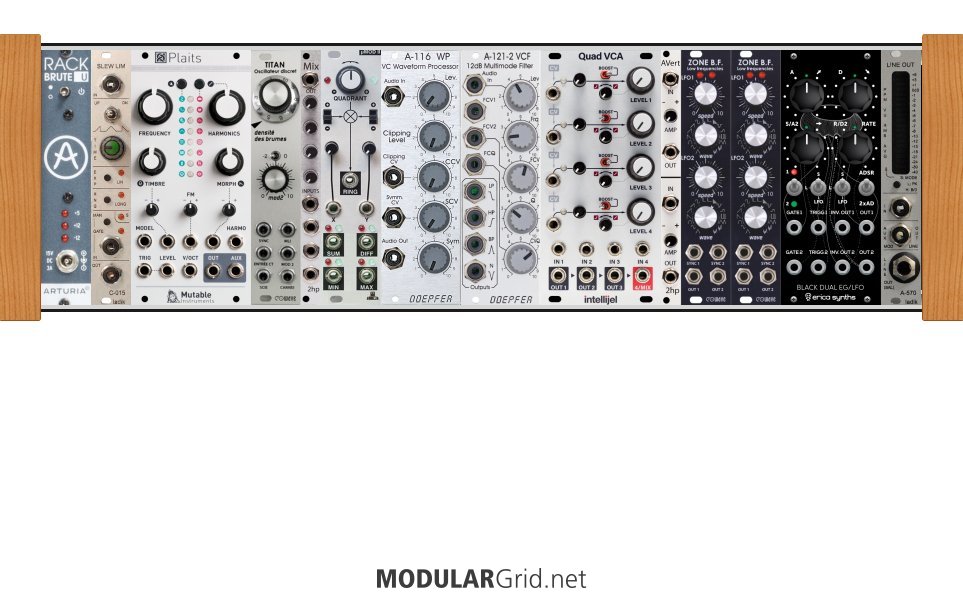...instead of a DIY kit, which means that you build the module yourself from directions, a bare PC board, individual electronic components, a panel and controls, and wire the whole mess up yourself with lots of soldering. Right. That's more what 'DIY' means 'round these parts, pilgrim.
OK, enough John Wayne for one day there...basics for under $1000, if possible, and definitely sub-$2000. Can it be done? Mmmmaybe. The initial stumbling block there involves the case and power supply, and while you can 'low-ball' a case, trying to go cheap on power components is a BAD idea. Power components can cause lots of damage if they fail, depending on how they fail. And current capacity is important, because you want to exceed the draw caused by the modules by enough headroom to assure that the power supply isn't overtaxed, which can lead to component failure and such. Also, one neglected bit here are power distro boards. Having filtering on the distribution rails is critical, as it helps reduce induced crud and noise on the rails as well as potential crosstalk between modules connected to it.
Right now, the best start-up case value is probably Arturia's Rackbrute 3U, which gives you a nice one-row cab with 88 hp (83 after their power supply goes in) and a consistently well-built power supply with ample amperage capacity for that single row. So, let's build with that.
Next, you'll need sources. These are the various 'generators' that output raw audio signals at the head of the chain. One is OK...but two is better, because there's a lot that can be done by syncing, crossmodulating, and detuning them against each other to achieve useful results beyond what most single VCOs can do. However, what I suggest is a fairly complex VCO as one, and something simpler as the other; this gives you a 'voice' VCO and a 'modulation' VCO, which works well in the way I mentioned above. Follow this with a mixer to combine the signals, but also add in a ring modulator so that the VCOs can be combined to create complex sum-and-difference sideband FM, if desired (if? hell, you'll desire it, no doubt!). That's the 'generator' stage.
Then we head into 'modifiers', things which alter timbral complexity and impose amplitude changes. Namely, filters, waveshapers, and VCAs. For a starting cab, one VCF with some interesting tricks is fine, as is a simple waveshaper. As for VCAs, though...this will find you wanting multiple VCAs, because some of these have uses for controlling control amplitudes as well as audio. Plus, if you can throw in a mixer, bonus. All easily done, as you'll see...
Next comes modulation sources, the 'controllers': LFOs and envelopes, plus a few other bits of trickery. Not many of these are needed for something this simple, but they're definitely key to making this work. And after that, 'processors', which includes any effects and the final mixer and output stage.
Basically, that's the block arrangement for ANY synthesizer: generator feeds modifier, both controlled by controllers and the results sent to the final processor. Any synth built along the 'classic' lines follows this simple four-part scheme. Granted, there's variations...but at the most basic level, these are the four parts that makes a synth a synth. For now, I'm going to leave drums and sequencing (sources and controllers respectively, fyi) out of this little build just to make the point clear and give you a good basic suggestion that follows the above narrative...so bear with me whilst I put my builder hat on...

Voila! Now, this is really basic, and while I couldn't bring it under $1000, it does come in at just under $2000 ($1923, to be exact, at normal retail prices).
If you look, this one-row synth is laid out exactly like the above example, with a couple of extra bits, those being a slew limiter (to allow glide-type effects for the VCO, VCF, or whatever shifting voltage you might want to smooth. It also only has an output stage, since the intent of the Quad VCA is to split the unit up into a couple of individual VCAs for control purposes, and a couple of others as a 2-channel VCA mixer, which then feeds directly to the output at the far right. This build here is a prime example of a very simple monosynth in Eurorack form: 2 VCOs, ring mod, waveshaper, VCF, 4 VCAs, 2 LFOs, 2 envelope generators (loopable), an output and a slew limiter, plus necessary mixing and attenuation for manipulating signal combinatins and levels. All you'd need to play this would be a keyboard that outputs CV and gate/trigger, such as Arturia's $119 Keystep, which also gives you a sequencer.
So, this is how a beginning one-row should look: these 'blocks', this sort of signal-flow (which happens when you follow a cohesive build pattern, instead of dropping modules in aimlessly), and so on. Your results may vary, of course, likely depending on which case size you opt to go with and what power supply seems right for it. My suggestion with those, however, would be to not do what I did here, and jam the rack out tightly from end to end. Instead, you should start with a bigger rack, because as you accumulate modules, ideas will present themselves as to how to expand those modules' capabilities, and then you'll need that extra room to expand these new modules into, as suggested by those ideas.
Also...take your time. More time spent with a resource like MG will allow you to examine all possibilities and refine your build before spending a cent, and that'll help when it does come time to drop some cash. Study other users' racks. See what works...and what clearly doesn't. Get your idea clearly fixed before you take the plunge with the Magic Plastic.

